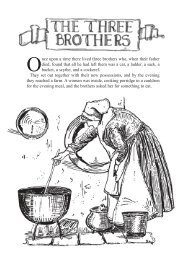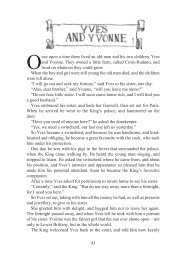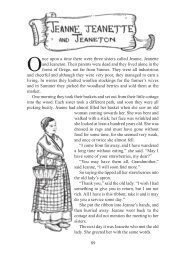Breton Horses - thecbj.com
Breton Horses - thecbj.com
Breton Horses - thecbj.com
You also want an ePaper? Increase the reach of your titles
YUMPU automatically turns print PDFs into web optimized ePapers that Google loves.
On & Off the Beaten TrackDagworth’s blinding stratagemI was about eight when I fi rst saw the battle sequence from Laurence Olivier’s Henry V in which the English archersdevastated the charging French knights. Later I learnt that 100 archers could release around 1000 arrows a minute.The battle of Crécy, in August 1346, seems generally credited with being the fi rst pitched battle in which the longbowwas successfully deployed. However, I recently discovered that a year earlier, in June 1345, there was a dressrehearsal just down the road from here at a place called Cadoret.Cadoret was the fi rst pitched battle in the war of the <strong>Breton</strong> Succession. (For those who do not know, Duke JeanIII of Brittany died and opposing factions claimed his throne. The French king supported one and the English king,Edward III, the other.) Though on nothing like the scale of Crécy, the Anglo-<strong>Breton</strong>s were signifi cantly outnumbered,with about 300 infantry and bowmen facing around 600 Franco-<strong>Breton</strong>s.The Anglo-<strong>Breton</strong>s were led by Sir Thomas Dagworth, an English captain who had considerable success in Brittanyoften against superior odds. Beyond the use of archers, it is interesting in that he chose to fi ght up hill. The valley wallsof the river Oust (now canalised) rise steeply at Cadoret. Dagworth was en route for Ploërmel. Having forded the riverand climbed the 100 metres or so to the top of the hill, he learned that Charles de Blois, leader of the Franco-<strong>Breton</strong>faction, was approaching from Josselin. The terrain was unpromising, however, he spotted a wooded gully leadingdown to the river. He established his defensive position at the bottom, facing uphill, leaving his infantry visible in thecentre, but concealing his archers in the trees on either side. He must also have realised that anyone on top of the hillwould be blinded by the declining sun. (I have stood there towards sunset and it is devastating.)De Blois attacked and his troops, already half blinded, were decimated by the lethal rain of arrows. An attempt tooutfl ank the Anglo-<strong>Breton</strong>s failed and a second attack was also rebuffed. Finally, Dagworth’s infantry charged up thehill and fi nished them off—a famous victory. This article <strong>com</strong>es with a history health warning: the original source is aFrench expert on the war of the <strong>Breton</strong> succession. However, English sources produce confl icting accounts. I wouldbe pleased to hear from anyone with a different version.Richard Griffi ths rg@<strong>thecbj</strong>.<strong>com</strong>How to get thereMap IGN 0919 E. From Josselin, take the D778 towards Loudéac. Two kilometres before Les Forges at Les Boulas, turn left onto the D157to Pleugriffet and immediately bear left towards Le Péer. After 500 metres, you will arrive at a crossroads with four exits. Take the second onthe right, towards a large farm building. 100 metres after the building the road turns sharply to the left and is joined from the right by a track.The position occupied by de Blois’ army will be in the field about 100 metres in front of you. The site of the battle is on private property; pleasedo not enter it if there are cows in the field and do ensure that the electric fence is left connected. To reach the valley, follow the road roundto the village of Couëdic and turn right. Once in the valley, turn left; Dagworth probably forded the river at Pomeleuc about four kilometresdownstream, an ancient crossing on the line of a Roman road.
















